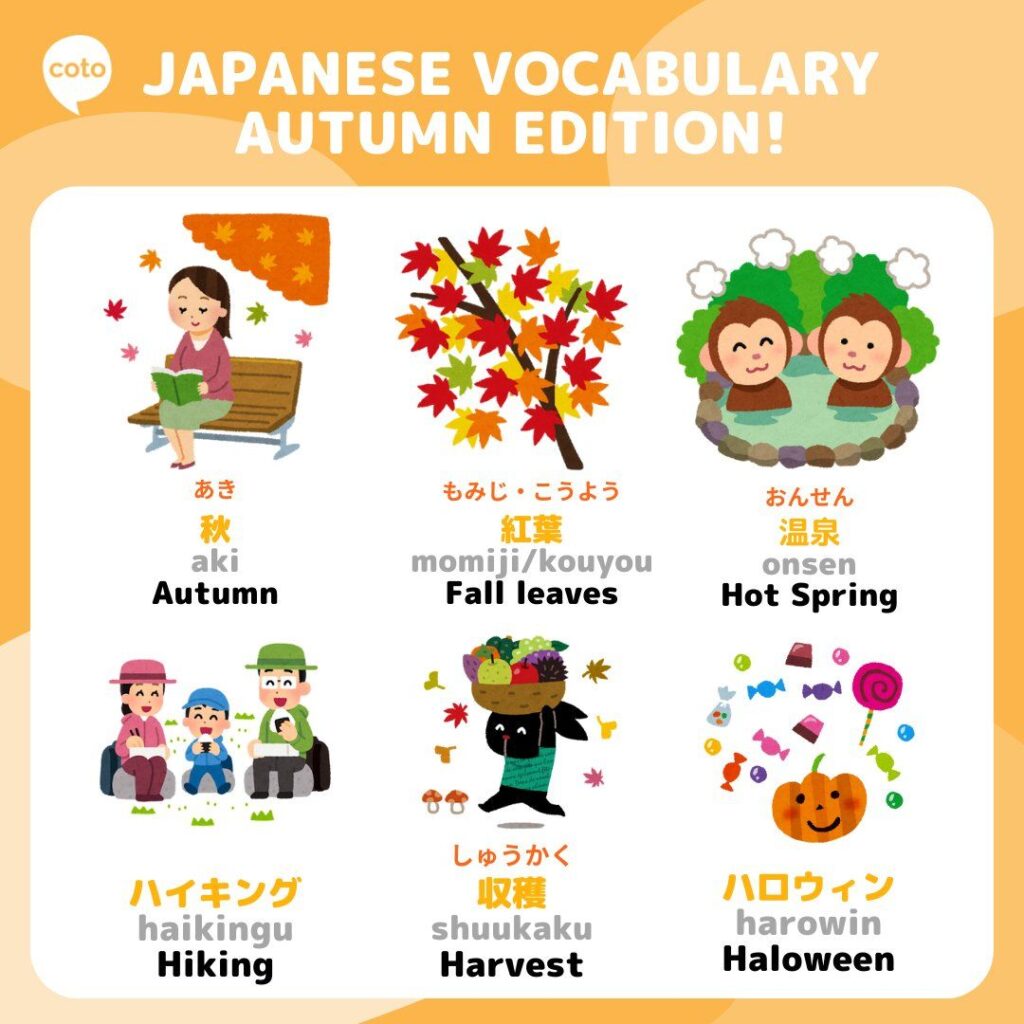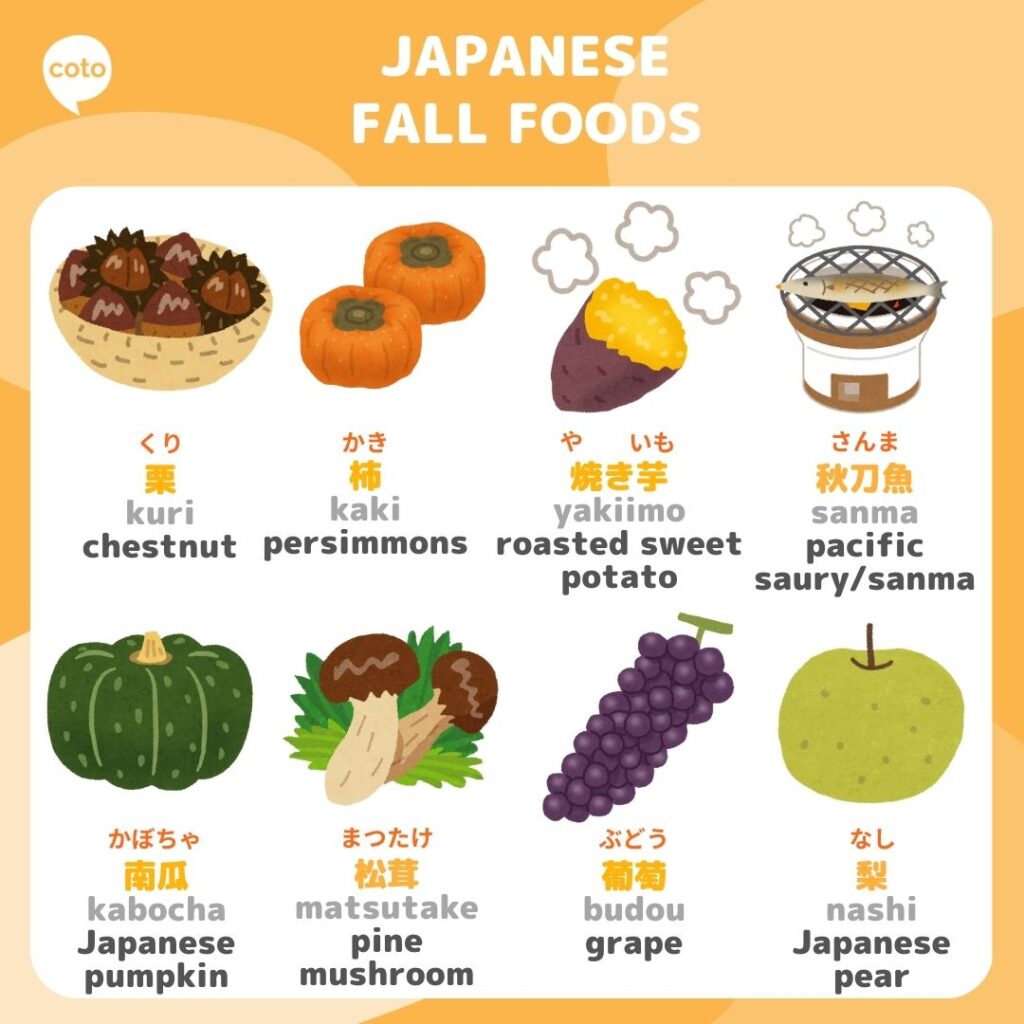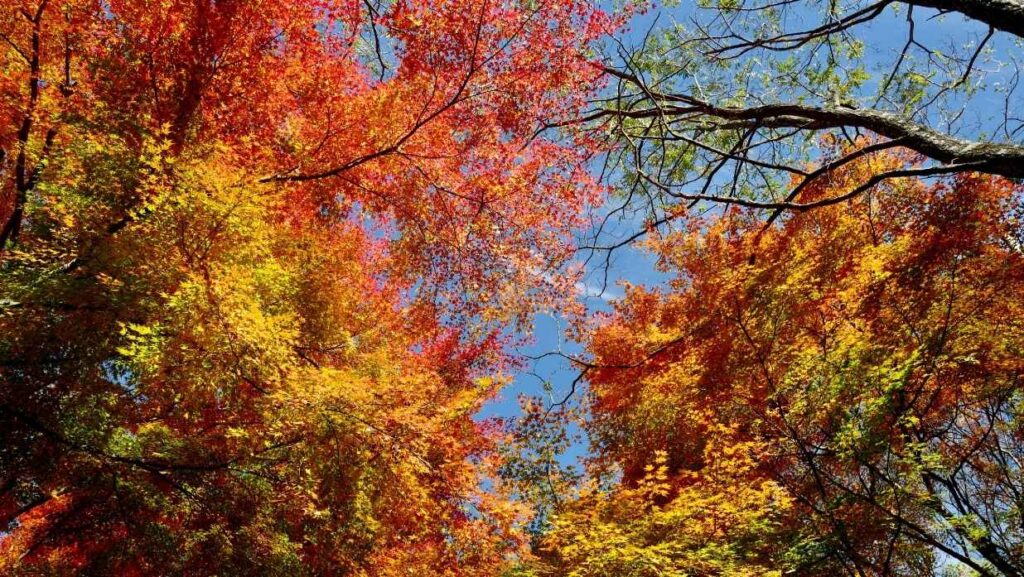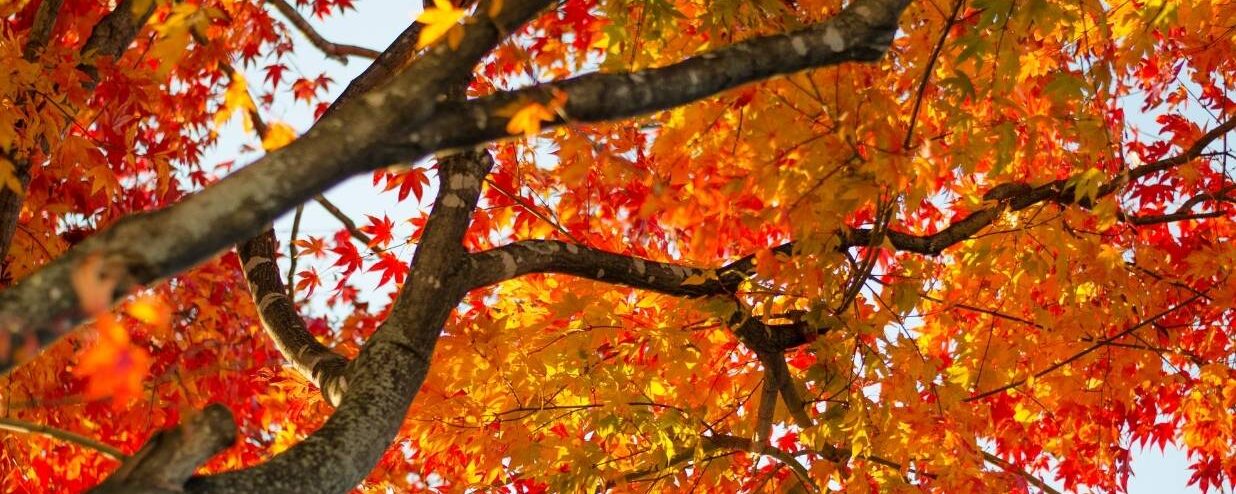It’s that time of year when the leaves burst into brilliant shades of red, gold, and when it finally feels socially acceptable to sip a satsumaimo (Japanese sweet potato) latte: autumn has arrived in Japan! Known as aki (秋), this season typically stretches from September to early December, reaching its peak during momiji season, when locals and travelers flock to parks and temples to admire the breathtaking autumn foliage. (Pro tip: check the nationwide autumn leaves forecast to catch the colors at their best!)
Japan’s crisp autumn is all about scenery, traditions, and flavors. And what better way to truly embrace aki than by learning some quintessential Japanese autumn vocabulary? We’ve gathered our favorite fall words, from the rustling leaves of momiji to the aroma of roasting chestnuts, perfect for anyone looking to savor Japan’s most cozy season.
Let’s take a look and learn!
Basic Japanese Fall Words

Spring, with its iconic cherry blossoms, might be the most famous season in Japan, but fall is also the perfect time to visit. While Japan experiences four distinct seasons, autumn has been growing increasingly popular in recent years. Let’s take a look at some basic Japanese autumn vocabulary first!
| Japanese | Reading / Pronunciation | Meaning |
| 秋 | aki | Autumn |
| 秋風 | akikaze | Autumn breeze |
| ハロウィン | harouin | Halloween |
| 紅葉 | momiji | Autumn leaves |
| 紅葉狩り | momijigari | Autumn leaf viewing |
| 月見 | tsukimi | Moon viewing festival |
| 七五三 | Shichi go san | Shichi-Go-San Festival |
| ハロウィン | Harowin | Halloween |
| 温泉 | Onsen | Hot spring |
| 収穫 | Shuukaku | Harvest |
| 新米 | Shinmai | New harvest rice |
| 登山 | Tozan | Mountain hiking |
| ハイキング | Haikingu | Hiking |
| 霧 | Kiri | Mist/fog |
| 9月 | Kugatsu | September |
| 10月 | Juugatsu | October |
| 11月 | Juuichigatsu | November |
| 12月 | Juunigatsu | December |
1. Aki (Fall)
The first word you will probably need to learn is, of course, autumn itself. Aki (秋) is the Japanese word for autumn.
日本の秋は美しいです。
Nihon no aki wa utsukushii desu.
Autumn in Japan is beautiful.
2. Harowin (Halloween)
The word ハロウィン (Harouin) is a loanword borrowed directly from English. In Japan, it’s less common for people to decorate their homes with elaborate displays, fog machines, or pumpkin carvings in their front yards. That said, Halloween has become a popular celebration influenced by Western traditions.
Instead of trick-or-treating, which is rare in Japan, the holiday is mostly celebrated with costumes, themed sweets, and citywide events, especially in urban centers like Tokyo. People often gather to dress up as their favorite characters.
In recent years, however, the rise in popularity and overtourism has led to stricter regulations, particularly in Tokyo’s Shibuya district. Measures have included banning alcohol sales at nearby convenience stores, setting curfews, and increasing police patrols to maintain order during the Halloween weekend.
3. Momiji (Autumn leaves)
The word momiji (紅葉) literally means “red leaves,” and it is closely tied to autumn in Japan. While it can generally refer to autumn foliage, most of the time it specifically describes the Japanese maple tree (Acer palmatum) and its vibrant crimson leaves.
4. Momijigari (Autumn leaf viewing)
Momiji is also central to the tradition of momijigari (紅葉狩り), or “autumn leaf hunting,” where people travel to famous spots to admire the seasonal colors, much like hanami in spring.
5. Tsukimi (Moon viewing festival)
Tsukimi (お月見), or “moon viewing,” takes place in mid-September to early October, depending on the lunar calendar. During Tsukimi, people gather to admire the full harvest moon, often decorating their homes with pampas grass (susuki) and offering seasonal foods like round rice dumplings (tsukimi dango), sweet potatoes, and chestnuts.
6. Shichi-Go-San (Shichi-Go-San Festival)
Another important autumn tradition is Shichi-Go-San (七五三), literally meaning “seven-five-three,” which celebrates the growth and health of children aged three, five, and seven. Held annually on November 15th, this festival sees children dressed in traditional kimono or formal attire visiting Shinto shrines with their families. The children are blessed for good health and longevity, and they often receive chitose-ame, a long, thin candy symbolizing a long and healthy life. S
Autumn Fall Foliage Vocabulary in Japanese
While the word momiji is perhaps most synonymous with autumn in Japan — similar to how sakura is associated with spring — did you know that the very same kanji used for momiji (紅葉) is also used for another autumn phenomenon called kouyou (紅葉)?
So what’s the difference between momiji and kouyou? Kouyou is a general term for autumn foliage in Japan, while momiji specifically refers to the intensely red leaves of the Japanese maple tree. Both words share the same “red leaf” kanji (紅葉) but describe different aspects of the same seasonal phenomenon: koyou encompasses all colorful leaves, including reds, yellows, and oranges, whereas momiji highlights the vibrant crimson hues of maples.
The activity of viewing these autumn leaves is called momijigari, or “red leaf hunting.” Let us take a look at other autumn foliage-related Japanese words!
| Japanese | Romaji | Meaning |
| 紅葉 | kouyou | Fall foliage |
| 落ち葉 | ochiba | Fallen leaves |
| 落葉 | rakuyou | Fallen leaves |
| 黄葉 | kouyou | Yellow leaves |
| 赤葉 | akiba | Red leaves |
| 彩り | irodori | Coloration or hues of leaves |
| 枯葉 | kareha | Withered or dead leaves |
| 錦秋 | kinshuu | Gorgeous autumn colors (poetic) |
| 紅葉前線 | kouyou zensen | Autumn leaf front (progression of colors across Japan) |
| 楓 | kaede | Maple tree |
| 銀杏 | ichou | Ginkgo tree or leaves |
| イチョウ並木 | ichou namiki | Ginkgo tree-lined street |
| 山紅葉 | yama momiji | Mountain autumn foliage |
| 紅葉狩り | momijigari | Autumn leaf viewing |
Autumn Food and Flavors in Japan

As Japan’s weather shifts from the unbearably hot and humid summer to the cooler, crisper days of autumn, the food lineup changes as well. Bright, tangy, and bold summer flavors give way to earthier, heartier, and more mellow tastes that usher the season in.
While pumpkin spice might be the quintessential autumn flavor in the United States, in Japan, autumn is dominated by root vegetables and ingredients like sweet potato, pumpkin, chestnut, and mushrooms, particularly the prized matsutake mushroom.
Let’s take a look at some Japanese autumn food–related vocabulary. We also have a separate guide on autumn flavors in Japan, so be sure to check that out!
| Japanese | Romaji | Meaning |
| 栗 | kuri | Chestnut |
| さつまいも | satsumaimo | Sweet potato |
| かぼちゃ | kabocha | Japanese pumpkin |
| 松茸 | matsutake | Matsutake mushroom |
| きのこ | kinoko | Mushroom |
| 秋刀魚 | sanma | Pacific saury |
| 柿 | kaki | Persimmon |
| 梨 | nashi | Japanese pear |
| 栗ご飯 | kurigohan | Chestnut rice |
| きのこご飯 | kinoko-gohan | Mushroom rice |
| もみじ饅頭 | momiji manju | Maple leaf–shaped cake |
| 栗きんとん | kuri kinton | Sweet mashed chestnuts |
Describing Fall Weather in Japan

We have a separate guide on how to describe the weather in Japanese, but we can’t create a Japanese autumn vocabulary without mentioning the weather. Autumn in Japan is one of the most pleasantly mild seasons, with temperatures cool enough to wear cozy sweaters, jeans, and boots, yet not so cold as to be uncomfortable.
| Japanese | Reading / Pronunciation | Meaning |
| 天気 | tenki | Weather |
| 気温 | kion | Temperature |
| 涼しい | suzushii | Cool |
| 晴れ | hare | Clear |
| 曇り | kumori | Cloudy |
| 雨 | ame | Rain |
| 霧 | kiri | Mist / Fog |
| 寒暖差 | kandansa | Temperature difference (day vs night) |
| 日が短い | hi ga mijikai | Shorter days |
| 夜 | yoru | Night |
| 風 | kaze | Wind |
Talking About Autumn in Japanese
Now that you’ve learned the basics and picked up the essential Japanese autumn vocabulary, it’s time to put them into practice! Let’s go through some common phrases and questions you’ll often hear, or might want to ask yourself, when talking about fall in Japan.
今日は秋風が気持ちいいです。
Kyou wa akikaze ga kimochi ii desu.
The autumn breeze feels nice today.
山の木々が赤や黄色に染まっています。
Yama no kigi ga aka ya kiiro ni somatteimasu.
The trees in the mountains are turning red and yellow.
ハロウィンではかぼちゃを飾ります。
Harouin de wa kabocha o kazari masu.
During Halloween, we decorate with pumpkins.
落ち葉の上を歩くのが楽しいです。
Ochiba no ue o aruku no ga tanoshii desu.
It’s fun to walk on fallen leaves.
公園で紅葉を見ました。
Kouen de kouyou o mimashita.
I saw the autumn leaves at the park.
秋は日が短くなります。
Aki wa hi ga mijikaku narimasu.
In autumn, the days become shorter.
Conclusion: Learn Beyond Japanese Autumn Vocabulary and Speak Japanese with Lessons at Coto Academy
Now that you’ve learned the basics of talking about the autumn in Japanese, why stop there? There are plenty of other essential skills to master, like introducing yourself or discussing a specific topic in conversation.
If you want to build confidence and start speaking Japanese, consider joining conversation-focused Japanese lessons at Coto Academy. As a top-rated school with campuses in Tokyo and Yokohama, we offer fun and flexible lessons designed around practical, everyday conversation. You’ll learn Japanese that you can use immediately outside the classroom.
We offer intensive Japanese courses as well as part-time options, so whether you want to immerse yourself fully or fit lessons into a busy schedule, there’s something for you. Start your journey to speaking Japanese confidently today!
Why join Coto Academy?
- Over 60+ different Japanese classes over 18 levels
- Small classroom of only up to 8 students for personalized support
- Professional, native Japanese teachers
Ready to get started? Fill out the form below to contact us!
FAQ
What is the Japanese word for autumn?
The Japanese word for autumn is 秋 (aki). It refers to the season of fall in general.
What is the Japanese word for autumn leaves?
Autumn leaves are called 紅葉 (momiji or kouyou). Momiji often refers to red maple leaves specifically, while kouyou can describe all colorful autumn foliage.
How do you say “autumn leaf viewing” in Japanese?
The activity of viewing autumn leaves is called 紅葉狩り (momijigari), which literally means “hunting red leaves.” It’s a popular seasonal activity similar to cherry blossom viewing (hanami) in spring.
What festivals are celebrated in Japan during autumn?
Popular autumn festivals include:
- ハロウィン (Harouin): Halloween
- お月見 (Tsukimi): Moon viewing festival
- 七五三 (Shichi-Go-San): Celebration for children aged 3, 5, and 7
What is the difference between momiji and kouyou?
Both words use the kanji 紅葉. Momiji usually refers specifically to the red leaves of maple trees, while kouyou is a broader term encompassing all autumn foliage colors, including red, yellow, and orange.
